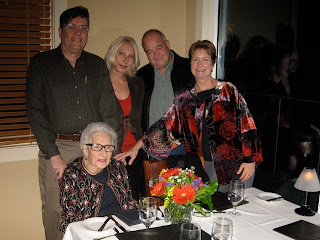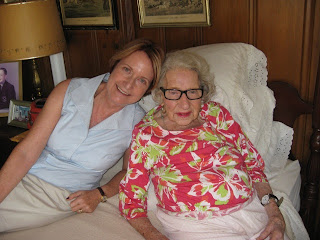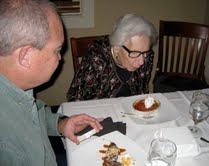She lived a classy life. And she died a classy death.
She was a link to the old America, but she was surprisingly aware, even hip.
Ronnie was an elegant woman — perfect hair, nice earrings, beautiful clothes, lipstick and makeup — with a sharp mind and a keen sense of humor who had more friends than anyone I know.
Mom was not the sort to brag about her accomplishments, but she played a big role in life around Annapolis we take for granted today.
She and her husband Tom, my father, helped bring many doctors down from Baltimore to live and practice in backwater Annapolis after World War II and hosted the first fundraiser to expand the downtown hospital. She was one of the founding members of the Hospital Auxiliary, helped found the Book Cart and started the Gray Ladies.
She was a member of the Board of Trustees of the Hammond Harwood House, cared for the house’s world famous Georgian door and led candlelight tours in period costume each Christmas. She was on the Board of the Annapolis Christ Child Society. She helped organize and host the Mint Julep fundraiser that saved the William Paca House. She also started the League of Women Voters in Annapolis and went around the county lobbying for the Marshall Plan to re-build Europe after the War. She was active in the Girl Scouts and helped start the Annapolis YWCA.
She packed a lot into her 92 years of exploration: working in New York City as a model for the Parisian perfume house of Lucien Lelong during World War II; and helping Tom start WANN, the first radio station in Annapolis.
Tom was executive secretary to Gov. Theodore McKeldin, and in eight glorious years assisting him, Ronnie socialized with movie stars like Fred Astaire, Dean Martin, Frank Sinatra and Jimmy Stewart during visits to Southern California. She attended the 1956 Republican Convention at the Cow Palace, in San Francisco, where they were part of President Eisenhower’s inner circle. She traveled on the Queen Elizabeth and the United States to Europe for Grand Tours of the continent. She visited Havana during the Cuban Revolution. She saw the Army-Navy football game in Philadelphia each year and sat in the Governor’s Box at the Preakness. She rode in one of the first cars to cross the newly opened Chesapeake Bay Bridge. She helped welcome President John F. Kennedy and British Prime Minister Harold McMillan at the Little White House in Key West and Queen Elizabeth and the King of Saudi Arabia at Government House.
Mom’s home was her greatest joy. In 1948, she and my father purchased Cliff Edge, overlooking the Severn and the Naval Academy, and she was the gracious hostess to countless guests over 65 years. During the McKeldin years, she hosted Roger Staubach and the Navy Cotton Bowl-winning football team for pool parties. Her house was always open.
My mother never got mad, and she never yelled. But she was as stubborn as a mule, and you were definitely going to do things her way.
Her way did not involve assisted living.
“I will not live with all those old people,” she used to say, up to the day before she fell.
I was with her that day for about four hours. We watched the British Open, and she cheered for favorite son Phil Michelson. We talked about politics. She had switched to Democrat in 2006, after being a lifelong Republican. She always loved hearing the latest political gossip.
And she told me that she was eternally grateful that I had let her stay in her house, even after many of her friends warned me that I was crazy to let someone so old live alone in that big house.
She knew she was going to fall because she had already taken a few spills, but she wanted to do it in her own home.
In her final years, she loved seeing her tulip magnolias in purple bloom, and watching the boats on the Severn River, the sun shining like diamonds on the water and the twinkling lights on the Academy Bridge as she fell asleep each night.
But she also told me she was really tired. Everything now seemed to take her forever to do. My mother was finally running out of gas, and she knew she wasn’t going to be able to live alone in her house much longer.
As I look back on that last day with her, I am pretty sure she was saying goodbye. My mother loved a good show, and I think she felt that it was time for her to leave the stage.
She fell out of bed the next morning and died nine days later.
In those wonderfully terrible days, she said goodbye to many of her friends, and she and I reminisced about old times for hours on end.
Her memory was still amazing.
When given the final choice, as the pneumonia took hold, she asked me to set her free. She was ready.
She told me the day we started the morphine, “I’m all used up. I just want to go to sleep.”
In the end, she died with great grace and dignity.
We should all be so lucky.
A Hopi Prayer
Do not stand at my grave and weep.
I am not there. I do not sleep.
I am a thousand winds that blow.
I am the diamond glints on snow.
I am the sunlight on ripened grain.
I am the gentle autumn rain.
When you waken in the morning’s hush
I am the swift uplifting rush.
Of quiet white doves in circled flight,
I am the soft stars that shine at night.
Do not stand at my grave and cry;
I am not there, I did not die.
© COPYRIGHT 2010 by New Bay Enterprises, Inc. All rights reserved.





















No comments :
Post a Comment